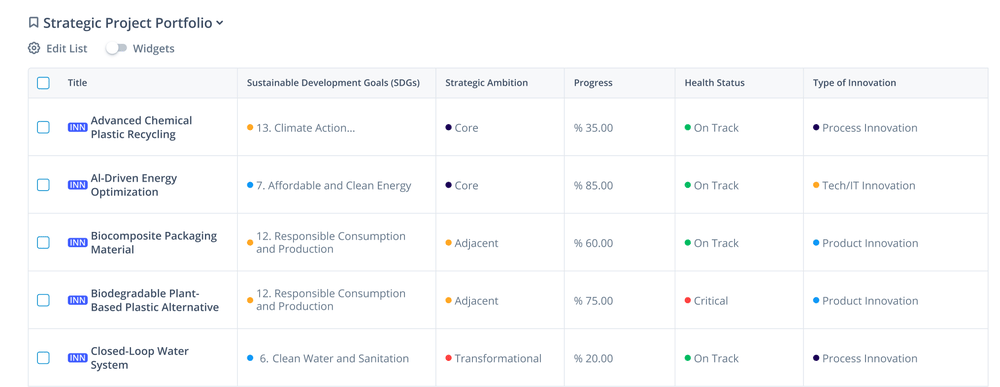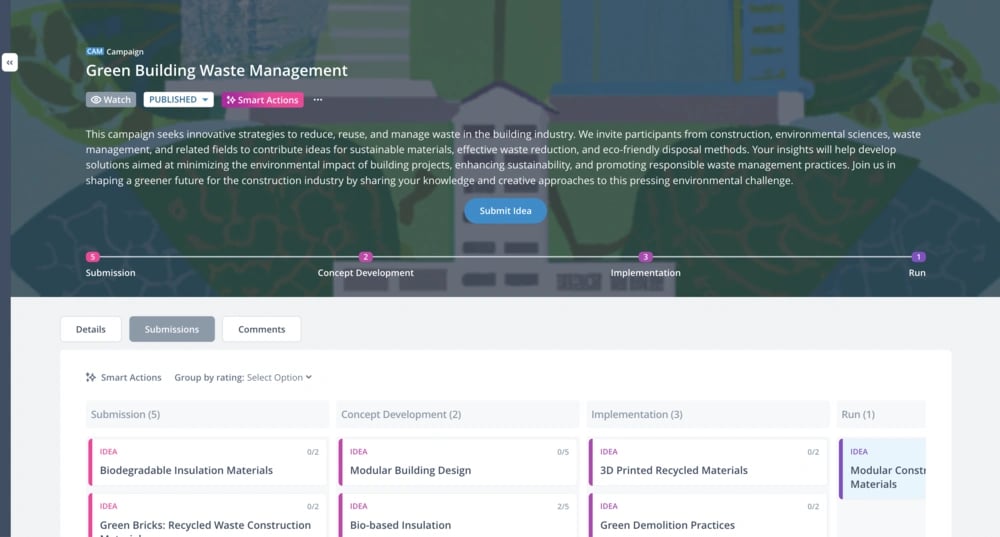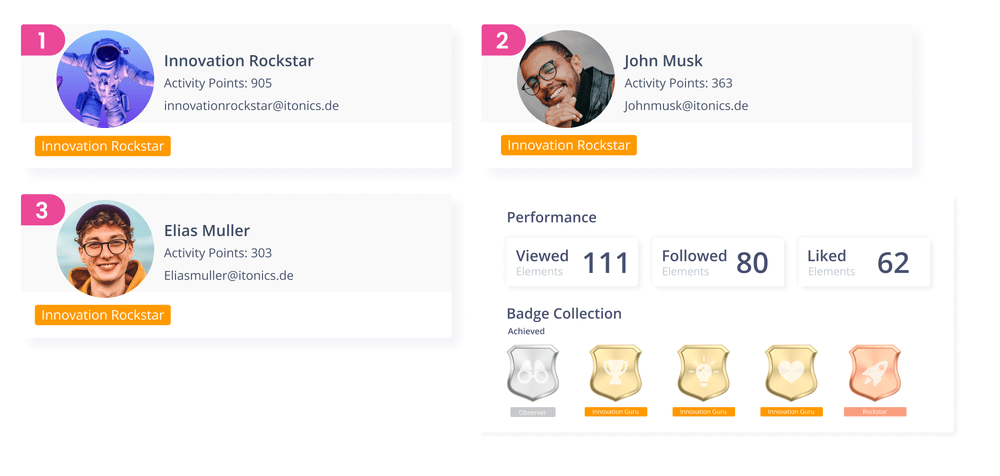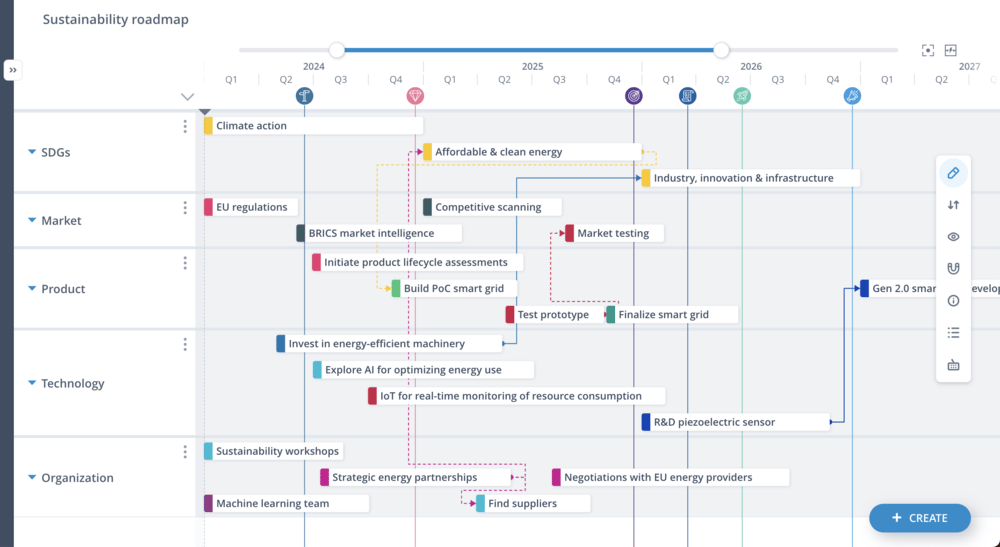In an era where environmental concerns are increasingly at the forefront of public consciousness, integrating sustainability into all innovation activities has become more than a mere trend—it's a necessity. As businesses and technological sectors evolve, the challenge lies not only in innovating to maintain a competitive advantage, but innovating in a way that is environmentally responsible and sustainable.
However, despite the near-ubiquitous awareness of the sustainability imperative, many organizations grapple with effectively embedding sustainability throughout their innovation activities. This challenge often stems from a poorly structured approach and inadequate or fragmented tools for aligning sustainability goals with innovation strategy.
This article aims to provide a guide on embedding sustainability into innovation processes. It explores best practice frameworks, approaches, and tools available in the ITONICS Innovation OS that promote end-to-end sustainability—from strategy development and nurturing an enabling culture to monitoring your portfolio initiatives—ensuring that every step of the innovation journey is aligned with both business and environmental goals.
How industry leaders embed sustainability in innovation
Integrating sustainability practices, including the Sustainable Development Goals (SDGs), into innovation management is a strategic approach that aligns business growth with environmental stewardship and social responsibility. This integration ensures that innovations drive economic success and contribute positively to society and the environment. Here's an overview of how this can be achieved, along with three illustrative examples from industry leaders:
Adopt a sustainability framework in innovation processes
In the quest to embed sustainability within innovation, adopting a structured framework is crucial. The right framework can help align innovation with global sustainability objectives so that every new development contributes positively to environmental and social goals.
Proven frameworks that promote strategy development for sustainable innovation:
1. Embedding SDGs in innovation:
Companies can use the SDGs to help steer their innovation strategy—setting objectives, identifying opportunities, and developing new products, services, or processes that contribute to these targets. This alignment can be effectively managed using ITONICS Portfolio, which helps track and align innovation projects with specific sustainability goals (Exhibit 1). With agile portfolio management software from ITONICS, companies can turn their innovation strategy into impact-driven action and sustainable value creation—which is what the SDGs are all about.

Exhibit 1: With strategic portfolios, innovation can be aligned with specific sustainability goals
Best practice from Unilever: Using the SDGs to identify strategic priorities and partnerships
Unilever’s TRANSFORM Program exemplifies how to embed sustainability in innovation by aligning with the SDGs. As explained by PJ Mistry, TRANSFORM Program Manager, Global Sustainability at Unilever, the program integrates SDG-driven impact pillars like waste management and health & well-being with a focus on Africa and Asia, ensuring that innovations contribute to key environmental and social objectives. Central to this strategy is the identification and support of startups and scaleups in these regions, aligning with Unilever’s strategic and sustainability goals. The program impacts three key areas: social & environmental, business, and employee aspects, showcasing a comprehensive approach to sustainable innovation that aligns with global sustainability targets.
2. Life cycle assessment (LCA):
The LCA approach involves evaluating the environmental impact of products or services throughout their entire lifecycle—from raw material extraction to disposal. By incorporating LCA into the innovation process, companies can make informed decisions that minimize environmental impacts. This comprehensive view enables innovators to identify potential areas for improvement, such as reducing energy consumption or using more sustainable materials, thus guiding sustainable product development.
3. Sustainable design thinking:
Sustainable design thinking ensures that new products or services are conceived with environmental and social responsibility at their core. This approach encourages innovators to think beyond traditional design parameters, considering factors like long-term environmental impact, resource efficiency, and social welfare. By embedding these principles early in the innovation process, companies can develop solutions that both create value for customers and contribute to a sustainable future.
Adopting a sustainability framework in innovation processes is vital for companies looking to contribute meaningfully to a sustainable future. These frameworks ensure that innovation efforts are environmentally sound, socially responsible, and aligned with global sustainability goals.
Foster a culture of sustainable innovation
Fostering a culture of sustainable innovation is critical for companies looking to integrate sustainability into every aspect of their business. This involves adopting new processes and frameworks, as described above, and, equally important, instilling a mindset across the organization where sustainability is viewed as integral to innovation.
Best-practice approaches for creating an environment where sustainability is not just a policy but a core value driving innovation:
1. Employee engagement:
Encouraging employees to be part of the sustainable innovation journey can significantly enhance the breadth and depth of ideas generated. With ITONICS Ideation, companies have a dynamic space where employees can actively contribute to sustainability initiatives (Exhibit 2). Our idea management software enables employees to capture, evaluate, prioritize, and develop their ideas for achieving sustainability goals. Such direct engagement ensures that sustainability becomes a shared objective, deeply integrated into the organization’s innovation ethos.

Exhibit 2: Ideation campaigns build the basis for company-wide collaboration
2. Stakeholder collaboration:
Another key aspect of sustainable innovation is engaging with a broader range of stakeholders—including customers, suppliers, and startups. Such collaboration can provide critical insights into the sustainability needs and opportunities specific to different groups. With ITONICS Open Innovation, companies can easily engage external stakeholders to contribute, enriching the innovation process with more diverse perspectives, ideas, and knowledge.
Best practice from PepsiCo: Solving sustainability challenges collaboratively
Kelly Van Dyke, Director of R&D External Innovation at PepsiCo, spearheads a collaborative approach to sustainable innovation with a strategic focus on sustainable packaging and regenerative agriculture. PepsiCo harnesses a diverse ecosystem of partners, including farmers, researchers, startups, and internal teams like Pep Labs. This collaboration is enabled via an open innovation portal, inviting broad participation and building a rich database of insights and ideas to efficiently align innovation efforts with business and sustainability goals. Through targeted ideation and a commitment to exploring beyond traditional networks, PepsiCo exemplifies how collective problem-solving can drive impactful, sustainable innovation.
3. Reward and recognition systems:
Implementing reward and recognition systems is shown to be highly effective for reinforcing and motivating sustainable innovation. These systems acknowledge and celebrate contributions that align with sustainability goals, fostering a more committed approach toward sustainable innovation. Gamification features in the Innovation OS can play a crucial role by introducing elements like points, badges, and leaderboards to recognize and incentivize employees who actively participate in sustainable innovation initiatives (Exhibit 3).

Exhibit 3: Gamification as a crucial incentive for employees
Incorporating engagement, collaboration, and recognition into the organizational culture helps drive a more sustainable innovation agenda. These elements are also the foundation for building a workforce aligned with and passionate about company sustainability goals.
Implement sustainability metrics in innovation management
In the pursuit of embedding sustainability in innovation, establishing and managing key performance indicators (KPIs) is critical. These KPIs, encompassing aspects like carbon footprint reduction, energy efficiency, or social impact, serve as tangible metrics to gauge the effectiveness of sustainable innovation initiatives. With ITONICS Portfolio, companies can effectively set, track, and analyze these sustainability KPIs and use agile Roadmaps to visualize the interplay between initiatives, milestones, and sustainability targets (Exhibit 4).

Exhibit 4: Sustainability roadmap to visualize the interplay of stakeholders
Best practice from the University of Cambridge: Aligning innovation initiatives with sustainability goals
Dr. Clemens Chaskel, Industrial Associate at the University of Cambridge’s Institute for Manufacturing, highlights the importance of using roadmapping to align innovation with sustainability goals. This approach breaks down strategies into specific initiatives and milestones, monitored for progress and adaptability to market changes. By incorporating multiple layers, such as foresight intelligence, product development, R&D, and go-to-market strategies, roadmaps provide a holistic view across various initiatives. This multilayer approach is integral for managing the complex interrelationships inherent in sustainable systems, where changes in one area can significantly impact another.
By reporting on both financial and sustainability metrics, companies can offer a comprehensive view of their performance. This dual reporting approach, supported by the ITONICS Innovation OS, provides insights into how innovation initiatives impact both the company’s bottom line and sustainability goals. It provides stakeholders with a clear understanding of the company’s commitment to sustainability and the tangible outcomes of its innovation efforts.
Implementing sustainability metrics and integrated reporting is vital for companies looking to fully embed sustainability into their innovation processes—to not just innovate for today but to do so in a way that is mindful of the impact on tomorrow.
Embed sustainability in innovation with ITONICS
In conclusion, integrating sustainability and SDGs into innovation management is a multifaceted process that requires a strategic approach, cultural shift, and the implementation of effective metrics. In doing so, companies can drive sustainable growth while contributing to the global agenda for a more sustainable future.
The ITONICS Innovation OS facilitates this integration by providing a structured, end-to-end innovation operating system where sustainability can be embedded into every stage of innovation, from foresight and strategy to ideation and portfolio management. The Innovation OS’ collaborative and smart features enable teams and stakeholders to work together seamlessly while increasing the speed, scale, and impact at which sustainable innovations are delivered to market.
Book a free demo to learn more about how industry leaders are making sustainability an integral and enduring part of the end-to-end innovation process using the ITONICS Innovation OS.
FAQs embedding sustainability in innovation
How do digital innovation platforms support sustainability initiatives?
Digital platforms like ITONICS help embed sustainability by linking innovation activities to SDGs, enabling collaboration, tracking sustainability metrics, and aligning portfolios with long-term environmental and social goals.
How can companies align innovation with sustainability frameworks?
Organizations can use structured innovation platforms to categorize ideas, technologies, and projects according to frameworks like the SDGs or ESG criteria to ensure traceable and strategic alignment.
Why is employee engagement important in sustainable innovation?
Engaging employees through digital ideation tools fosters a shared sustainability mindset and crowdsources actionable solutions from across the organization, accelerating green transformation efforts.




